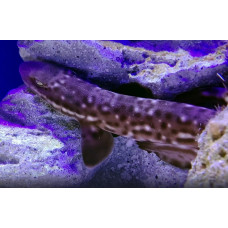Latin name
Atelomycterus macleayi
Other name
Atelomycterus macleayi
Identification
Australian marbled catsharks have an elongated, slender, almost cylindrical body that tapers slightly towards the tail. The snout is short, less than the width of the mouth.
Features of fish fins
Dorsal spines (total): 0; Anal spines: 0.
Fish colouring
The basic colouration of the Australian marbled catshark is light grey with alternating dark grey stripes and numerous black spots.
Distribution
It is an endemic species that inhabits a very limited area, probably not exceeding 20,000 square kilometres. It occurs in the tropical coastal waters of Western Australia between Port Hadland and Melville Island.
Habitat
A tropical marine species associated with reefs. Their depth range is from 0.5 to 3.5 metres. These sharks prefer sandy or rocky bottoms.
Size
The maximum length of the Australian marbled catshark is 60cm.
Behavior
These sharks are most active at night. They are able to make quick jumps, change direction quickly and have excellent reactions.
Food and feeding habits
The Australian marbled catshark feeds on invertebrates and smaller fish.
Reproduction
Males and females become sexually mature when they reach 48 cm and 51 cm respectively. This species reproduces by laying eggs about 6.6 cm long and 2.1 cm wide. The young are about 10 cm long.
Fishing
This species of shark has no commercial value.
Relationship with a person
Australian marbled catsharks are not dangerous to humans.
| Classification | |
| Phylum | Chordata |
| Class | Chondrichthyes |
| Squad | Carcharhiniformes |
| Family | Atelomycteridae |
| Genus | Atelomycterus |
| Species | A. macleayi |
| Features | |
| Conservation status | Least Concern |
| Habitat | Pelagic |
| Life span, years | No information |
| Maximum body weight, kg | No information |
| Maximum length, cm | 60 |
| Sailing speed, m/s | No information |
| Threat to people | Edible |
| Way of eating | Predator |

